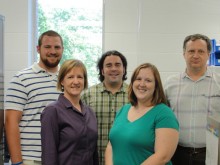Channels
Special Offers & Promotions
University of Iowa
 Researchers at
the Department of Communication Sciences & Disorders at the University of
Iowa in the US replicate the stresses that affect the human voice. The team
studies how vibration affects laryngeal cells, using a rotational shear
rheometer from Malvern Instruments coupled with a piezo-electric driver to
measure viscoelastic properties of soft tissues. The
team is also part of the National Center
for Voice and Speech (NCVS), a
consortium of voice researchers and professionals from institutions across the
country.
Researchers at
the Department of Communication Sciences & Disorders at the University of
Iowa in the US replicate the stresses that affect the human voice. The team
studies how vibration affects laryngeal cells, using a rotational shear
rheometer from Malvern Instruments coupled with a piezo-electric driver to
measure viscoelastic properties of soft tissues. The
team is also part of the National Center
for Voice and Speech (NCVS), a
consortium of voice researchers and professionals from institutions across the
country. Dr Sarah A. Klemuk, Assistant Research Scientist, said; "Our voice is easy to take for granted, until we lose it. For those who use their voice as a primary tool of trade however, knowing how to protect the ability to talk clearly is critical. Singers, actors, ministers and coaches all rely on talking to carry out daily duties. School teachers, however, are the most likely to experience problems - they are two to thirty-two times more likely to have a voice problem in their lifetime than other professional voice users. Our research aims to help professional speakers save their voices."
We generate sound when our laryngeal muscles draw the vocal cords (now known as vocal folds) together and airflow from the lungs causes them to vibrate. The exchange of energy between the air stream and the tissue sets the tissue into sustained vibration - a purely biomechanical oscillation of the soft, non-muscular layers of the vocal folds known as the lamina propria. The ability of the vocal folds to vibrate is therefore directly connected to their viscoelastic properties. Pathologies such as nodules, polyps, scarring or sulcus are the result of a change in vocal fold viscoelasticity. Toughened tissues make voicing sound rough, talking becomes difficult and it is harder to be understood. To soften damaged vocal folds or reduce scarring, surgeons use injectables in the lamina propria of the vocal fold. For these materials to improve voice quality, they must have viscoelastic properties well-matched to the native tissues.
In her most recent paper (Klemuk et al, Laryngoscope 120: May 2010) Dr Klemuk delivers results demonstrating that accurate measurements of the influence of vocal fold [cord] injectables on viscoelasticity are now possible at physiological frequencies.
She explains; "The rheology system we have set up allows us to gather data on how cells in the larynx respond to vibrations at particular frequencies over time; simulating everything from normal, conversational speech - around 125 Hertz in males and 200-220 Hz in females - to situations of over use. Our results can help steer laryngologists towards selecting the most appropriate injectable in those cases where damage has already been done. We also intend to increase our general understanding of how our vocal cords function so we might develop prevention techniques."
"The rheology is collected using a thoroughly vetted Gemini rheometer, known to be accurate and reliable at low frequencies in the range 0.01-100 Hz. A specialized piezo-electric drive unit coupled to the rheometer is then applied to multiple samples across frequencies in the range 1- 2000 Hz, allowing confirmation of accuracy in the overlapping measurements in the 1- 100 Hz cross over," continued Dr Klemuk. "By characterizing the viscoelastic properties of human vocal folds, engineers can optimize the material formulation to suit actual frequencies that humans use in speech."
Malvern rheometers are used around the world in research, product development and quality control applications. The company's instrument portfolio includes strain and stress controlled rheometers to enable complete viscoelastic characterization of a wide range of materials, from thin fluids to solid like materials over an extremely wide stress, strain and temperature range. For further information visit; www.malvern.com/rheometry
Media Partners


